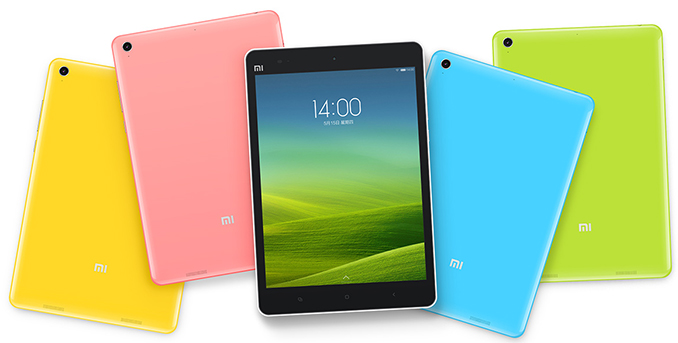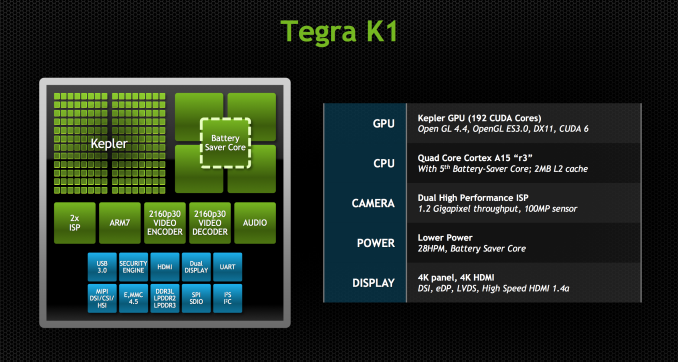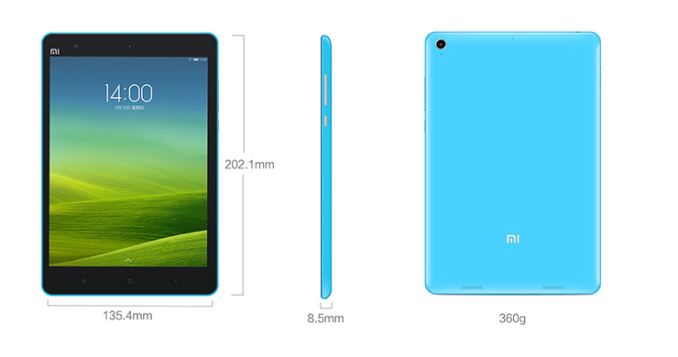Xiaomi Announces the MiPad: The First Tegra K1 Device
by Brandon Chester on May 15, 2014 9:40 AM EST
Today Xiaomi introduced its first tablet: the MiPad. The tablet bears similarity to both Apple’s iPad Mini and iPhone 5c. On the front of the tablet we have a 7.9” 2048x1536 IPS display (sourced from both Sharp and AUO Optronics) which is surrounded by an asymmetrical bezel. On the back we have a plastic shell of multiple different colors which Xiaomi itself states is made with the same injection molding technology as the iPhone 5c. There is also an 8MP Sony camera on the back with an F/2.0 aperture, and a 5MP camera on the front. The most interesting part of the Mi Pad is not on the outside, it's on the inside. The MiPad is the first consumer device to be announced that is powered by NVIDIA's Tegra K1 SoC.
As you may recall, NVIDIA introduced Tegra K1 to the world at CES 2014. It marks a huge departure from NVIDIA's mobile graphics strategy, abandoning the old Tegra GPU roadmap in favor of its desktop Kepler architecture.
Tegra K1 has two flavors, both built on a 28nm HPm process. One uses NVIDIA's Project Denver which will include two custom ARMv8 cores designed by NVIDIA. Denver is not slated to ship until later this year and so what we see in the MiPad is the other flavor of Tegra K1 which is a quad core ARM Cortex A15 design. Similar to other recent Tegra SoCs, this version of the K1 features four Cortex A15s plus an additional companion Cortex A15 optimized for lower frequencies for periods of low CPU usage. The CPU cores are based on a newer revision of Cortex A15 (r3p3) which includes finer grain power gating to reduce power consumption compared to revision r2p1 in the Tegra 4. This increase in efficiency will help balance out NVIDIA's move from a 1.9GHz max clock speed on Tegra 4 to over 2GHz on Tegra K1 (the move to 28nm HPm should help as well). The Tegra K1 SoC in the MiPad will ship with a max clock speed of 2.2GHz and 2GB of LPDDR3 RAM.
The GPU on Tegra K1 is something completely different from previous Tegra designs. Previous Tegra chips integrated NVIDIA's GeForce ULP core designed exclusively for its mobile platforms. With Tegra K1 Nvidia abandoned the idea of having a separate mobile roadmap for GPU designs and has merged its mobile and PC GPU roadmaps. The result is that Tegra K1 and all subsequent designs will ship with GPUs using the same architecture as NVIDIA's PC parts. With Tegra K1 we get a complete implementation of NVIDIA's Kepler architecture with 192 CUDA cores, 4 ROPs, and 8 texture units. It also brings along OpenGL ES 3.0, OpenGL 4.4, DirectX 11, CUDA 6.0, and every other API that Kepler supports.
NVIDIA has also shown a commitment to releasing software that will take advantage of their mobile GPUs. The company recently worked with Valve to bring Half Life 2 and Portal over to the NVIDIA Shield which is powered by a Tegra 4 CPU and I am sure that crafty users will bring the apps over to Tegra K1 devices if NVIDIA does not do so itself.
Beyond the SoC, the other internal specs for the MiPad include a 25.46 Whr (6700mAh) battery, 16 or 64GB of internal NAND, and a MicroSD slot. Connectivity includes support for 802.11 b/g/n/ac and Bluetooth 4.0. As with other Xiaomi devices, the MiPad runs Android with the MIUI UI atop it. It will launch in China sometime in June priced at 1499 yuan ($240) for the 16GB model and 1699 yuan ($272) for the 64GB model.












82 Comments
View All Comments
masimilianzo - Thursday, May 15, 2014 - link
I would literally love a review of this device..And in general review of the chinese devices like Meizu, Nubia, Lenovo, Vivo and so on..you would a chinese editor I guessMondozai - Thursday, May 15, 2014 - link
Most smartphones released by Chinese OEMs are for the Chinese market only. Only the major players like Huawei, ZTE and others release their phones to other markets, and even then it is done selectively. All of them have many models which are only for China.Xiaomi themselves are slowly rolling out their international presence but not in the West, at least not yet.
Having an editor covering the Chinese market only makes sense if most of the phones/tablets being sold there are also being sold in the Western world.
alexvoda - Thursday, May 15, 2014 - link
Not so.I believe Anandtech as a technology blog reports on the latest technology, not just technology available to some markets.
Even if such devices are not available to the west it is important to have reviews of them in order to compare them to available ones.
masimilianzo - Thursday, May 15, 2014 - link
I agree, chinese products reviews would be great, since these brands are emerging at a very fast rate they are very interesting.spider623 - Tuesday, June 3, 2014 - link
you can actually get all xiaomi products from there not so official(official by the international translation teams)dealer, check miuiandroid(UK, now xiaomi.eu) for the name of the dealer and his websitesciwizam - Thursday, May 15, 2014 - link
From Engadget: http://www.engadget.com/gallery/xiaomi-tablet-laun...Looks like it's 2x faster than the Apple A7 in GFX Bench3, according to Xiaomi
nathanddrews - Thursday, May 15, 2014 - link
Impressive... that A7 is that good compared to a company that's been doing graphics exclusively for 20 years. A8 will be out this year as well and will likely close the gap a bit.I got so excited when I saw "AUO Optronics". I used to follow SED/FED technologies intently until almost every company backed off except AUO.
ams23 - Thursday, May 15, 2014 - link
NVIDIA and Xiaomi deserve some credit here. In a tablet that has roughly the same external dimensions and internal battery capacity as the ipad Mini Retina, the MiPad with Tegra K1 has 2.3x better GPU performance! The Kepler GPU in Tegra K1 is not just the fastest and most power efficient ultra mobile GPU, but is also the most advanced ultra mobile GPU for graphics/compute workloads too (full support for DX12, OpenGL 4.4, CUDA 6, etc). This is arguably one of the most revolutionary ultra mobile graphics processor that the world has ever seen. And it doesn't end here: the Tegra Erista Maxwell GPU will be ~ 1.6x faster than the Tegra K1 Kepler GPU at the same power consumption levels, and first silicon should start sampling sometime over the next few months.grahaman27 - Thursday, May 15, 2014 - link
Cant wait for the Denver version to hit the market, I really would like to see nvidia integrate their LTE modem into the maxwell version next year.Flunk - Thursday, May 15, 2014 - link
You're looking at this wrong, It's very impressive that a new $240 tablet can outperform last year's top-end iPad Air in any benchmark.